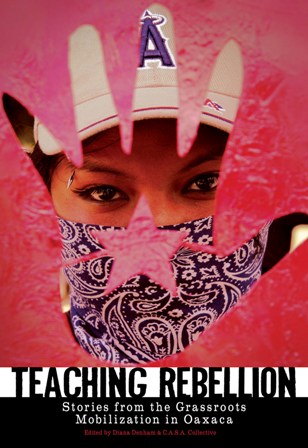Teaching Rebellion

Voices from Oaxaca
Teaching Rebellion: Stories from the Grassroots Mobilization in Oaxaca
Edited by Diana Denham and the C.A.S.A. Collective
PM Press, 2008, 384 pages, $21.99
Women take to the streets with pots and pans to occupy the state-run radio station, men throw rocks in defense against police gunshots, and youth create their own community protection force. These are just a few of the stories in Teaching Rebellion, a collection of personal accounts of the uprising in Oaxaca in 2006. The book offers a view into the personal pain and triumph of the everyday people who fought injustice after the government attacked a teachers strike in downtown Oaxaca.
The personal accounts make up 23 chapters, each by a different person who lived through or was connected to the movement. The book highlights teachers, grandmothers, young people, community organizers, and religious figures whose collective thoughts flesh out a narrative of the events that unfolded.
The theme throughout the compilation is the ability of people to come together in a traditional indigenous community and hold a corrupt government accountable. As Padre Arias writes in his chapter, “The indigenous tradition of community and equality—a society which is dedicated to meeting the needs of each member rather than enriching itself—is key to achieving the goal of social equality in Oaxaca.”
The book is brimming with examples of nonviolent resistance in the face of an oppressive government that wishes to extinguish all forms of public dissidence. There are also examples of the community fighting back physically by throwing rocks and other common objects. As Sara, the communications director of the Oaxacan Human Rights Network Rights, warns in her chapter, increased violence is a threat as the people grow more frustrated with the government. “The movement that has organized over the past year has been a peaceful one. There have been confrontations, but the people have been unarmed,” she writes. “However, the risk is there. As the people begin to recognize that institutionally and peacefully there is no chance of resolving the problem … we are likely to see an increase in violence in the future.”
Teaching Rebellion offers a great perspective on the creation of the Popular Assembly of the People of Oaxaca and the strength of the people to organize themselves against injustice. Though they were being shot at, teargassed, and disappeared by thousands of armed officers, the people of Oaxaca did not back down. With minimum violence and incredible coordination of resources and skills, Oaxacans started one of the most important social movements of our lives, which continues to this day.
